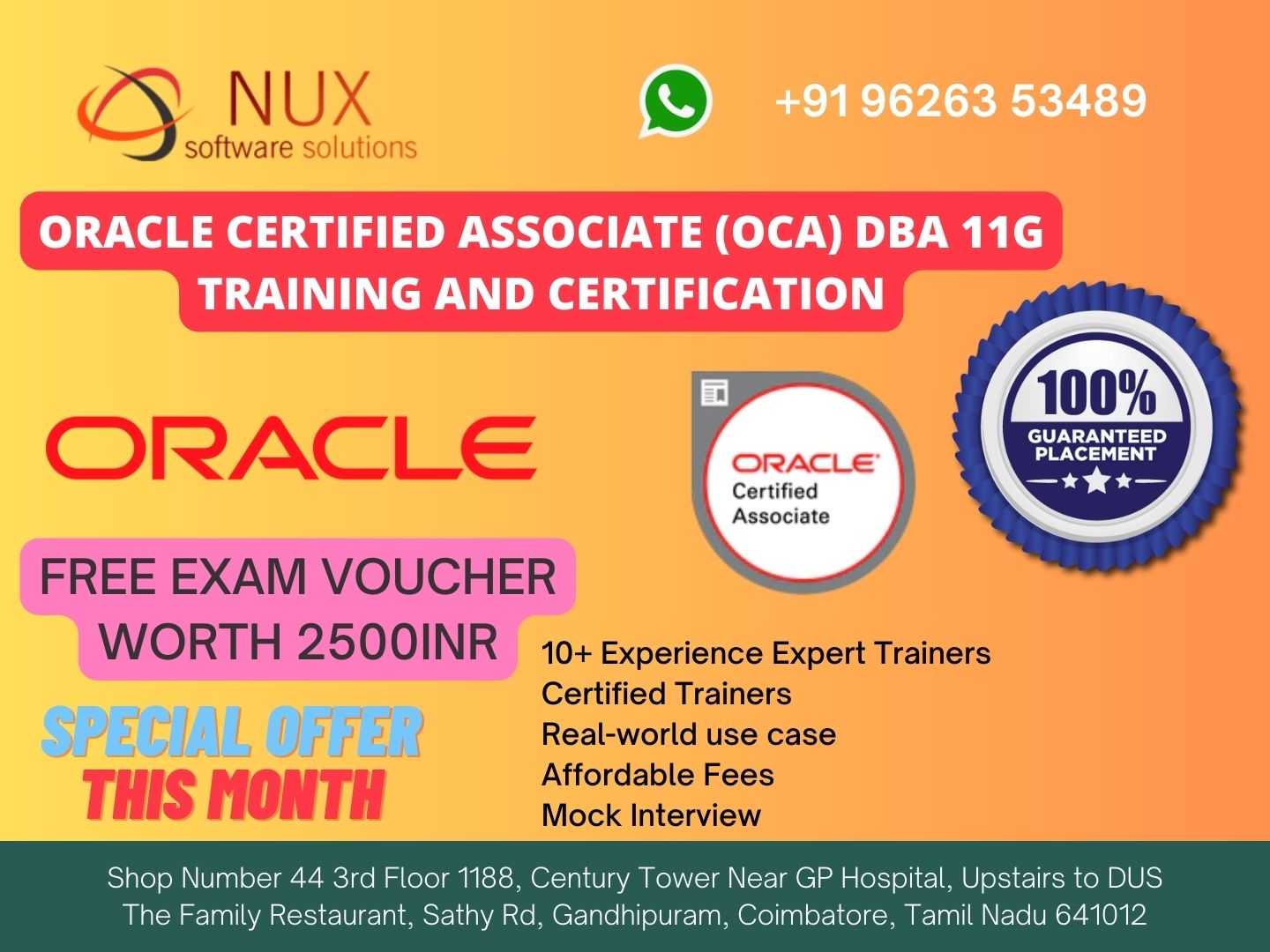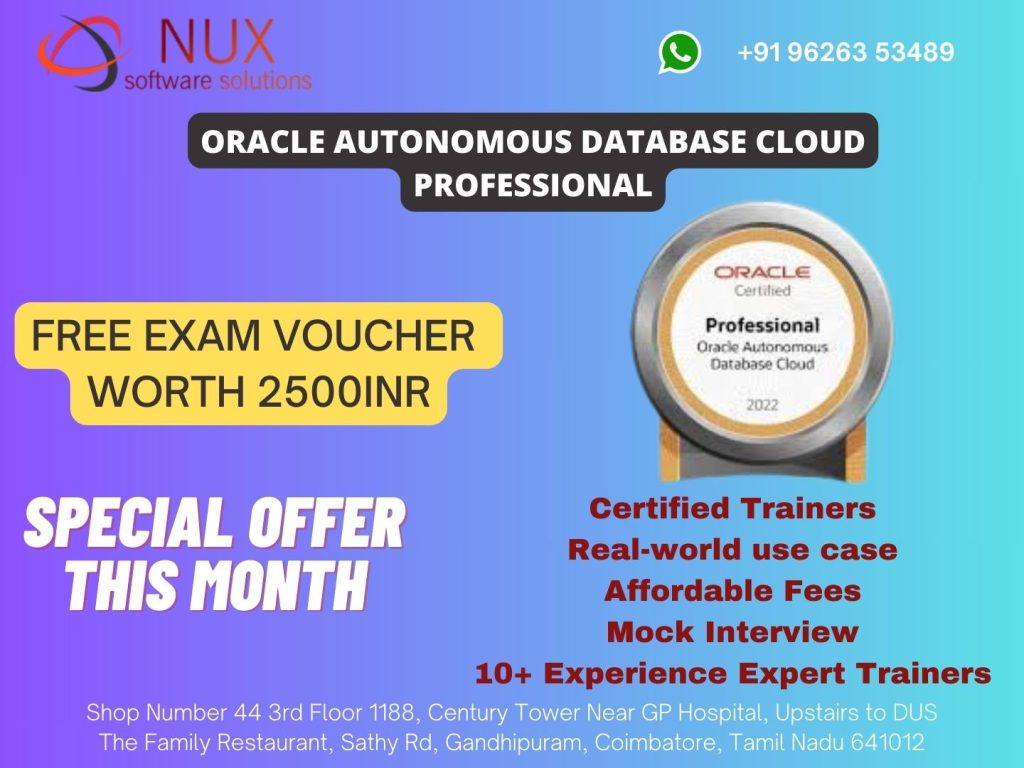Oracle Certified Associate (OCA) DBA 11g

Course Summary
This course is designed for aspiring database professionals who want to begin their career with Oracle Database technology by achieving the Oracle Certified Associate (OCA) DBA 11g certification. It covers core database concepts, SQL fundamentals, and essential administrative tasks for managing Oracle 11g environments.
The training prepares candidates to clear the two required certification exams:
1Z0-051 – Oracle Database: SQL Fundamentals
1Z0-052 – Oracle Database 11g: Administration I
By completing this course, students gain the foundational knowledge needed to manage Oracle databases, perform basic installations, back up and recover data, and ensure secure database operations.
Why Choose This Course
Oracle is a global leader in enterprise database solutions, and OCA 11g remains a widely respected credential. This course helps you:
Begin your Oracle DBA journey with a recognized and structured learning path
Develop essential skills in SQL, data management, and database operations
Get hands-on experience with Oracle Database 11g tools and architecture
Prepare for higher certifications such as OCP 11g, 12c, or 19c
Learn from certified Oracle professionals with real-world implementation experience
Who Should Enroll
This course is ideal for:
Aspiring database administrators (DBAs) starting their Oracle journey
Computer science students and graduates pursuing a career in data management
IT professionals transitioning into database roles
Professionals preparing for the OCA DBA 11g certification exams
Companies training junior staff for database support and maintenance tasks
Skills You Will Gain
Understanding the Oracle Database architecture and storage structures
Writing and executing SQL queries to retrieve, update, and manipulate data
Managing users, privileges, and database security
Performing basic backup, restore, and recovery operations
Monitoring database performance and troubleshooting issues
Installing and configuring Oracle Database 11g for test and production environments
Career Benefits
After completing this course, you will:
Be prepared to pass the Oracle 1Z0-051 and 1Z0-052 exams, earning the OCA DBA 11g credential
Qualify for entry-level roles like Oracle DBA Associate, Junior DBA, or Database Support Analyst
Build a solid foundation for OCP-level and cloud database certifications
Boost your résumé with a recognized Oracle credential valued across industries
Strengthen your technical profile for IT, finance, telecom, government, and software sectors
Launch Your Oracle DBA Career with OCA Certification
Oracle OCA 11g certification opens the door to a high-demand career in database administration. This training gives you the foundation you need to grow into advanced roles and certifications.
Start your DBA journey with expert-led training at Linux Training Center.
Course Syllabus
Modules
Introduction
Listing the features of Oracle Database 11g
Chapter 1 :
Discussing the basic design, theoretical and physical aspects of a relational database, Describing the development environments for SQL, Describing Oracle SQL Developer, Describing the data set used by the course
Chapter 2 :
Retrieving Data Using the SQL SELECT Statement, Listing the capabilities of SQL SELECT statements, Generating a report of data from the output of a basic SELECT statement, Using arithmetic expressions and NULL values in the SELECT statement, Using Column aliases, Using concatenation operator, literal character strings, alternative quote operator, and the DISTINCT keyword, Displaying the table structure using the DESCRIBE command
Chapter 3 :
Restricting and Sorting Data, Writing queries with a WHERE clause to limit the output retrieved Using the comparison operators and logical operators, Describing the rules of precedence for comparison and logical operators, Using character string literals in the WHERE clause, Writing queries with an ORDER BY clause to sort the output, Sorting output in descending and ascending order, Using the Substitution Variables
Chapter 4 :
Using Single-Row Functions to Customize Output, Differentiating between single row and multiple row functions, Manipulating strings using character functions, Manipulating numbers with the ROUND, TRUNC and MOD functions, Performing arithmetic with date data, Manipulating dates with the date functions
Chapter 5 :
Using Conversion Functions and Conditional Expressions, Describing implicit and explicit data type conversion, Using the TO_CHAR, TO_NUMBER, and TO_DATE conversion functions, Nesting multiple functions, Applying the NVL, NULLIF, and COALESCE functions to data, Using conditional IF THEN ELSE logic in a SELECT statement
Chapter 6 :
Reporting Aggregated Data Using the Group Functions, Using the aggregation functions in SELECT statements to produce meaningful reports, Using AVG, SUM, MIN, and MAX function, Handling Null Values in a group function, Creating queries that divide the data in groups by using the GROUP BY clause, Creating queries that exclude groups of date by using the HAVING clause
Chapter 7 :
Displaying Data from Multiple Tables, Writing SELECT statements to access data from more than one table, Joining Tables Using SQL:1999 Syntax, Viewing data that does not meet a join condition by using outer joins, Joining a table by using a self join, Creating Cross Joins
Chapter 8 :
Using Sub-queries to Solve Queries, Using a Subquery to Solve a Problem, Executing Single-Row Sub-queries, Using Group Functions in a Sub-query, Using Multiple-Row Subqueries
Using the ANY and ALL Operator in Multiple-Row Sub-queries
Chapter 9 :
Using the SET Operators, Describing the SET operators, Using a SET operator to combine multiple queries into a single query, Using UNION, UNION ALL, INTERSECT, and MINUS Operator
Using the ORDER BY Clause in Set Operations
Chapter 10 :
Manipulating Data, Adding New Rows to a Table Using the INSERT statement, Changing Data in a Table Using the UPDATE Statement, Using DELETE and TRUNCATE Statements, Saving and discarding changes with the COMMIT and ROLLBACK statements, Implementing Read Consistency, Using the FOR UPDATE Clause
Chapter 11 :
Using DDL Statements to Create and Manage Tables, Categorizing Database Objects, Creating Tables using the CREATE TABLE Statement Describing the data types, Describing Constraints
Creating a table using a subquery, Altering and Dropping a table



